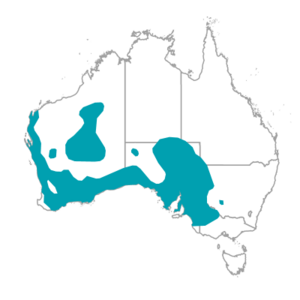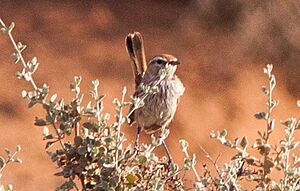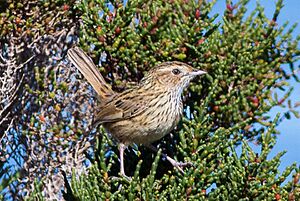Rufous fieldwren facts for kids
Quick facts for kids Rufous fieldwren |
|
|---|---|
 |
|
| Conservation status | |
| Scientific classification | |
| Genus: |
Calamanthus
|
| Species: |
campestris
|
 |
|
| The full geographic range of the C. campestris and ssp. | |
The rufous fieldwren (Calamanthus campestris) is a small bird found only in Australia. It is also known as the desert wren or sandplain wren. This bird loves to eat insects and belongs to a bird family called Acanthizidae.
Contents
About the Rufous Fieldwren
The rufous fieldwren is part of a large bird family called Acanthizidae. This family has 63 different types of birds. Some other birds in this family are gerygones, scrubwrens, and thornbills.
Different Types of Rufous Fieldwrens
Scientists group animals into different types called subspecies. The rufous fieldwren has several subspecies, which are slightly different versions of the same bird.
Here are some of them:
- C. c. winiam - found in southeastern Australia.
- C. c. campestris - found in southern South Australia.
- C. c. rubiginosus
- C. c. dorrie
- C. c. hartogi
- C. c. wayensis
- C. c. isabellinus
- C. c. montanellus
Sometimes, scientists disagree on whether a subspecies should be its own species. For example, the C. montanellus (Western Fieldwren) is sometimes seen as a separate species and sometimes as a subspecies of the rufous fieldwren. Recent studies suggest it might just be a type of rufous fieldwren.
What Does It Look Like?
The rufous fieldwren is a small bird. It is about 11.5 to 13.5 centimeters (4.5 to 5.3 inches) long. Its wingspan is about 15.5 to 19.5 centimeters (6.1 to 7.6 inches). It weighs between 11 and 16 grams (0.38 to 0.56 ounces).
The different subspecies have slightly different looks. They vary in the color of their backs, bellies, and how many stripes they have.
- Some subspecies, like C.c. campestris, have grey backs with a little bit of reddish-brown. Their bellies are creamy with dark stripes.
- Others, like C.c. winiam, have grey backs and thick stripes on their undersides.
- Some, like C.c. Isabellinus, have rich reddish-brown upper parts and cinnamon-colored bellies with very faint stripes.
- Island subspecies, like C.c. Dorrie, have pale-grey upper parts and white undersides with some stripes.
- The C.c montanellus is the darkest type. It has an olive-grey back and a pale yellow belly.
Female rufous fieldwrens look similar to males. Females usually have a slightly duller stripe above their eye. In the C. montanellus subspecies, males have a white chin and throat, while females have yellowish-white ones.
Both male and female rufous fieldwrens sing. Their song is a happy, clear whistle that sounds like whirr-whirr-chick-chick-whirr-ree-ree. They usually sing from the top of small bushes. They sing mostly during their breeding season. You can often hear them at sunrise and for about 30 minutes after sunset. When they are alarmed, they make sharp chrr-r-r and han-han-han calls.
Rufous fieldwrens are usually seen alone or in pairs. Sometimes, you might see them in small family groups of up to five birds. They often join other small birds like inland thornbills and shy heathwrens. They usually hold their tail straight up when hopping on the ground. When they run, they might flatten their tail.
It's hard to confuse the rufous fieldwren with other birds if you get a good look. However, it looks a bit like the striated fieldwren. You can tell them apart by where they live. Rufous fieldwrens like low shrubs or heathland. Striated fieldwrens prefer tall grass or wet areas.
The rufous fieldwren has greyer upper parts and whiter undersides. Its beak is longer and curves downwards. The striated fieldwren has a straighter, wedge-shaped beak and more stripes.
Where Do They Live?
Rufous fieldwrens live in different areas across the southern parts of mainland Australia. They are found in many separate groups.
Their Homes
Because they live in many different places, rufous fieldwrens live in various habitats.
- Birds in the west like dry, open woodlands and coastal heaths.
- On the north-west Nullarbor Plain, they live in areas with pearl bluebush and other shrubs like mallee paperbark.
- In the dry and semi-dry central parts of Australia, they live in shrublands and heathlands. They like areas with saltbush, bluebush, and samphire shrubs.
- Eastern populations live in rocky areas with spinifex grass and eucalypt trees. You might also see them in the Little Desert National Park in Victoria, among small mallee eucalypts and spinifex grasslands.
How They Live
Reproduction and Life Cycle
Rufous fieldwrens can breed from June to April. In some areas, like Western Australia, they can breed all year round. They build their nests on the ground, often hidden under shrubs or clumps of grass. Sometimes, nests are found on soil mounds or in low branches of plants like saltbush.
Their nests are round or dome-shaped. They are about 15.2 centimeters (5.98 inches) long and 10.2 centimeters (4.01 inches) wide. They are made from strips of bark or fine dry grass. The inside of the nest is soft, lined with wool, fur, feathers, or plant fluff. One nest was even found with feathers from Australian magpies and brown falcons!
The female bird likely sits on the eggs alone. We don't know exactly how long the eggs take to hatch. Most nests have 3 or 4 eggs, but sometimes only two.
The eggs are smooth and shiny, shaped like an oval. They are about 19 to 22 millimeters (0.74 to 0.86 inches) long. The color of the eggs can vary by location. Eggs from inland areas are usually pale chocolate-colored. Eggs from coastal areas can be buff salmon, chocolate-red, or chestnut-brown.
Both parents help feed the young birds, called fledglings. The young birds depend on their parents for up to 17 days. If people disturb their nests, the birds might leave their eggs or young. Sometimes, other birds like pallid cuckoos lay their eggs in the rufous fieldwren's nest, tricking the fieldwrens into raising their young.
What Do They Eat?
Rufous fieldwrens are mainly insectivores, meaning they eat insects. They mostly eat beetles, wasps, and small grasshoppers. They also sometimes eat small spiders, snails, and seeds from certain plants.
Threats to Rufous Fieldwrens
The places where rufous fieldwrens live are shrinking. This is mainly because of too much grazing by farm animals, clearing land for farms, and weeds taking over. This has caused some groups of rufous fieldwrens to become smaller and more separated.
These birds can stay in an area until almost all their hiding places are gone. Sometimes, rows of trees planted to block wind can provide a suitable home for them.
For isolated groups of these birds to survive, their remaining habitats need to be protected. Planting new vegetation to connect different areas can help. Fires can also be a big threat, leading to local extinctions. Even with farm animals, wild cats, and occasional large fires, a subspecies of rufous fieldwren still lives on Dirk Hartog Island.
How Are They Protected?
The International Union for Conservation of Nature (IUCN) keeps a list of threatened species. They have listed the rufous fieldwren as "Least Concern". This means they are not currently in danger of disappearing.





